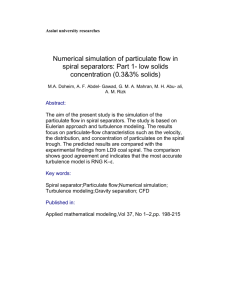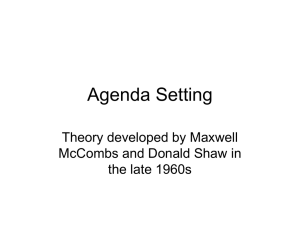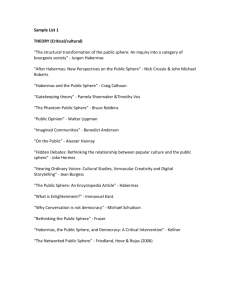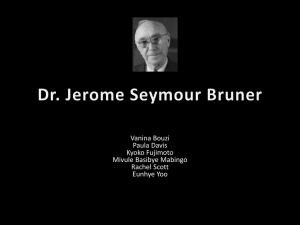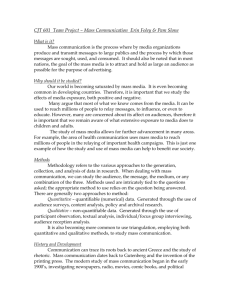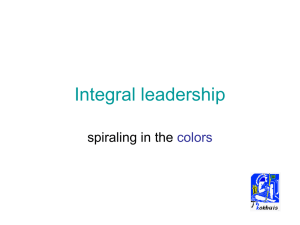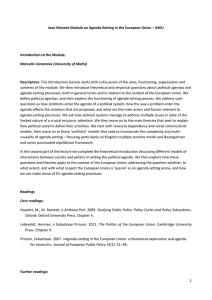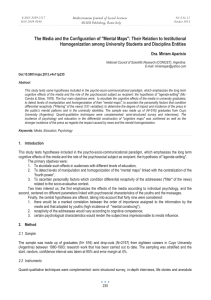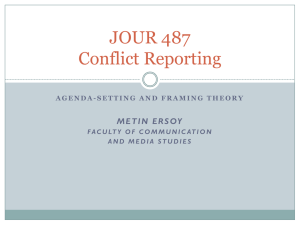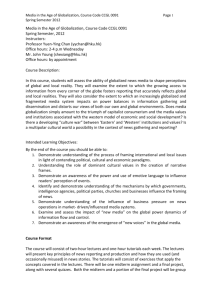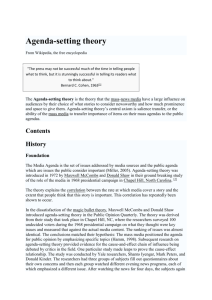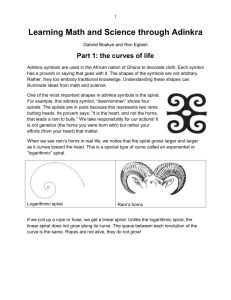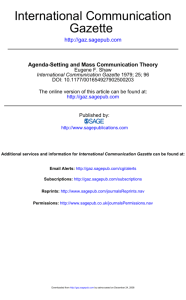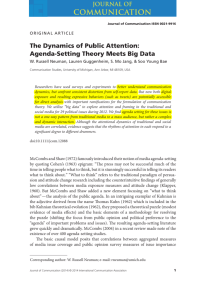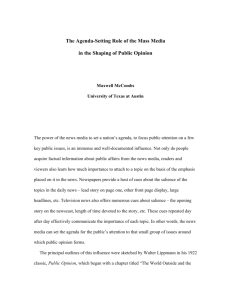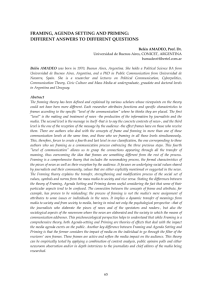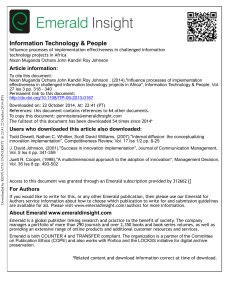a fundamental theory in journalism
advertisement
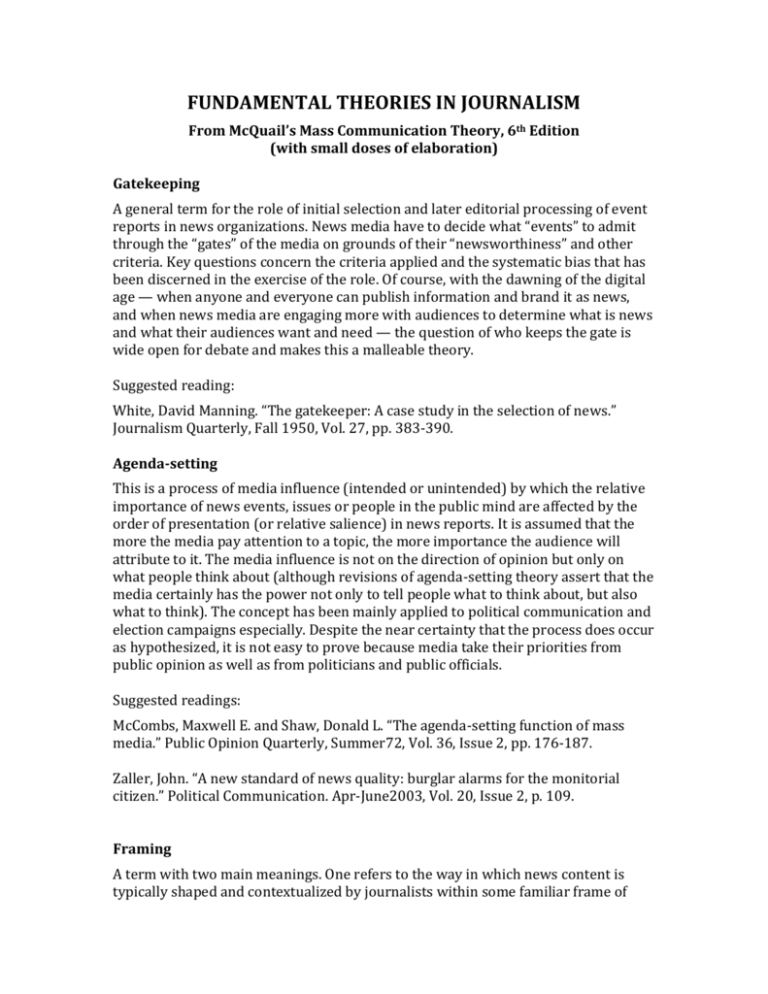
FUNDAMENTAL THEORIES IN JOURNALISM From McQuail’s Mass Communication Theory, 6th Edition (with small doses of elaboration) Gatekeeping A general term for the role of initial selection and later editorial processing of event reports in news organizations. News media have to decide what “events” to admit through the “gates” of the media on grounds of their “newsworthiness” and other criteria. Key questions concern the criteria applied and the systematic bias that has been discerned in the exercise of the role. Of course, with the dawning of the digital age — when anyone and everyone can publish information and brand it as news, and when news media are engaging more with audiences to determine what is news and what their audiences want and need — the question of who keeps the gate is wide open for debate and makes this a malleable theory. Suggested reading: White, David Manning. “The gatekeeper: A case study in the selection of news.” Journalism Quarterly, Fall 1950, Vol. 27, pp. 383-390. Agenda-setting This is a process of media influence (intended or unintended) by which the relative importance of news events, issues or people in the public mind are affected by the order of presentation (or relative salience) in news reports. It is assumed that the more the media pay attention to a topic, the more importance the audience will attribute to it. The media influence is not on the direction of opinion but only on what people think about (although revisions of agenda-setting theory assert that the media certainly has the power not only to tell people what to think about, but also what to think). The concept has been mainly applied to political communication and election campaigns especially. Despite the near certainty that the process does occur as hypothesized, it is not easy to prove because media take their priorities from public opinion as well as from politicians and public officials. Suggested readings: McCombs, Maxwell E. and Shaw, Donald L. “The agenda-setting function of mass media.” Public Opinion Quarterly, Summer72, Vol. 36, Issue 2, pp. 176-187. Zaller, John. “A new standard of news quality: burglar alarms for the monitorial citizen.” Political Communication. Apr-June2003, Vol. 20, Issue 2, p. 109. Framing A term with two main meanings. One refers to the way in which news content is typically shaped and contextualized by journalists within some familiar frame of reference and according to some latent structure of meaning. Nearly every decision journalists make while reporting a story – whom they will interview and whom they will not, where an interview will take place, what questions will be asked, what the lead and nut graph will be — is an act of framing. A second, related meaning concerns the effect of framing on the public. The audience is thought to adopt the frames of reference offered by journalists and to see the world in a similar way. This process is related to priming and agenda-setting. Suggested reading: Capella, J.N., and Jamieson, K.H. “Spiral of cynicism: the press and the public good,” Chapter 3, “Framing the News.” Oxford University Press. New York. 1997 Uses and Gratifications A version of individualist functional theory and research that seeks to explain the uses of the media and the satisfactions derived from them in terms of the motives and self-perceived needs of audience members. This is also one version of “active audience” theory and has been applied in the study of media effects on the grounds that any effect has to be consistent with the needs of the audience. Suggested reading: Kaye, Barbara K., and Johnson, Thomas J. “Online and in the know: uses and gratifications for the web.” Journal of Broadcasting and Electronic Media. Mar2002, Vol. 46, Issue 1, p. 54. Spiral of Silence A concept that describes one version of the “third-party effect” in opinion formation: the tendency for people to be influenced in what they think (or say they do) or by what they think other people think. The term was first applied by Elizabeth NoelleNeumann to refer to the tendency for those who think they hold a minority or deviant view to refrain from expressing it in public, thus accelerating the dominance of a supposed consensus (the spiraling effect). The hypothesis is based on a presumed fear of isolation. The main thrust of the theory is to attribute to the media a powerful effect, since they are the main source of what people think is the dominant opinion of the moment. Also related to the better-known bandwagon effect, whereby apparent front-runners pick up support solely because they are the front-runners. Suggested reading: Lee, Na Yeon, and Kim, Yonghwan. “The spiral of silence and journalists’ outspokenness on Twitter.” Asian Journal of Communication. May2014. Vol. 24, Issue 3, pp. 262-278. Spiral of Cynicism A hypothetical process, similar to the spiral of silence, whereby persistently negative media coverage of a political campaign and politicians, especially where this emphasizes insincerity, corruption, dirty tricks, personal ambition and ignores substance and honest intention, is thought to create a climate in which trust and the desire to participate in the democratic process is diminished. In effect, the thesis holds that the more exposure to the media, the less there will be public trust and participation. The causes are held to lie especially in the process of “mediatization” and are also linked to media logic. Suggested readings: Capella, J.N., and Jamieson, K.H. “Spiral of cynicism: the press and the public good,” Chapter 3, “Framing the News.” Oxford University Press. New York. 1997. Patterson, Thomas. “Doing well and doing good: How soft news and critical journalism are shrinking the news audience and weakening democracy — and what news outlets can do about it. Joan Shorenstein Center on the Press, Politics and Public Policy, John F. Kennedy School of Government, Harvard University, 2000.



